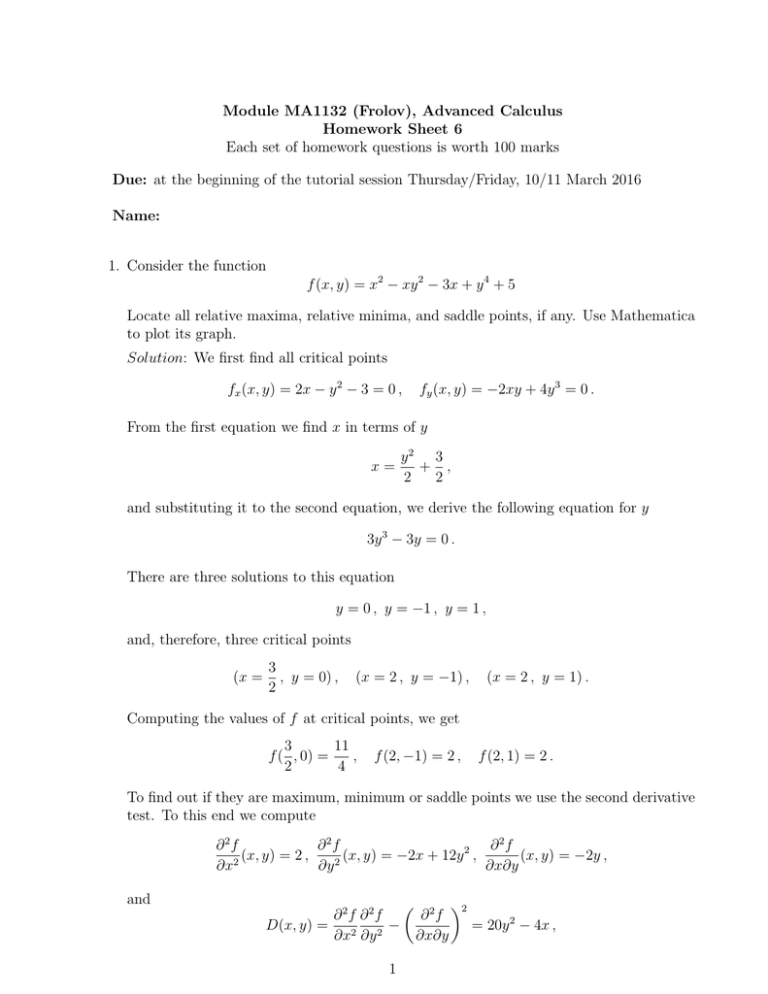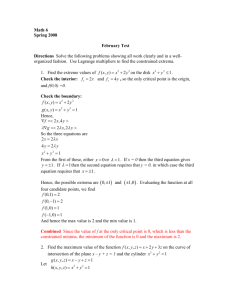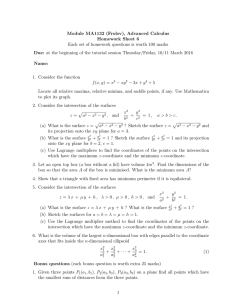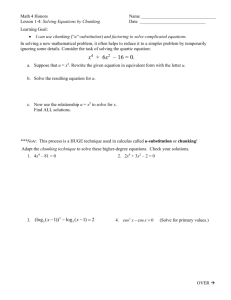Module MA1132 (Frolov), Advanced Calculus Homework Sheet 6
advertisement

Module MA1132 (Frolov), Advanced Calculus Homework Sheet 6 Each set of homework questions is worth 100 marks Due: at the beginning of the tutorial session Thursday/Friday, 10/11 March 2016 Name: 1. Consider the function f (x, y) = x2 − xy 2 − 3x + y 4 + 5 Locate all relative maxima, relative minima, and saddle points, if any. Use Mathematica to plot its graph. Solution: We first find all critical points fx (x, y) = 2x − y 2 − 3 = 0 , fy (x, y) = −2xy + 4y 3 = 0 . From the first equation we find x in terms of y x= y2 3 + , 2 2 and substituting it to the second equation, we derive the following equation for y 3y 3 − 3y = 0 . There are three solutions to this equation y = 0 , y = −1 , y = 1 , and, therefore, three critical points (x = 3 , y = 0) , 2 (x = 2 , y = −1) , (x = 2 , y = 1) . Computing the values of f at critical points, we get 11 3 , f ( , 0) = 2 4 f (2, −1) = 2 , f (2, 1) = 2 . To find out if they are maximum, minimum or saddle points we use the second derivative test. To this end we compute ∂ 2f ∂ 2f ∂ 2f 2 (x, y) = 2 , (x, y) = −2x + 12y , (x, y) = −2y , ∂x2 ∂y 2 ∂x∂y and ∂ 2f ∂ 2f D(x, y) = − ∂x2 ∂y 2 1 ∂ 2f ∂x∂y 2 = 20y 2 − 4x , Computing D and ∂2f ∂x2 for the three critical points, we get 3 D( , 0) = −6 , 2 ∂ 2f 3 ( , 0) = 2 , ∂x2 2 and therefore (0 , 23 ) is a saddle point. D(2, −1) = 12 , ∂ 2f (2, −1) = 2 , ∂x2 and therefore (2, −1) is a relative minimum. D(2, 1) = 12 , ∂ 2f (2, 1) = 2 , ∂x2 and therefore (2, 1) is a relative minimum too. The graph of the function is shown below 2. Consider the intersection of the surfaces z= p a2 − x2 − y 2 , and x2 y2 + = 1, b2 c2 a > b > c. p p (a) What is the surface z = a2 − x2 − y 2 ? Sketch the surface z = a2 − x2 − y 2 and its projection onto the xy plane for a = 3. 2 2 (b) What is the surface xb2 + yc2 = 1 ? Sketch the surface onto the xy plane for b = 2, c = 1. x2 b2 + y2 c2 = 1 and its projection (c) Use Lagrange multipliers to find the coordinates of the points on the intersection which have the maximum z-coordinate and the minimum z-coordinate. 2 Solution : (a) It is the upper semi-sphere of radius a. Its projection onto the xy plane for a = 3 is a circle of radius 3. (b) It is an elliptic cylinder. Its projection onto the xy plane for b = 2, c = 1 is an ellipse with semi-axis 2 and 1. (c) To find zmax nd zmin we use the Lagrange multiplier method, and get the equations − x x = 2Λ 2 , z b y y − = 2Λ 2 , z c z= p a2 − x 2 − y 2 , x2 y 2 + 2 = 1. b2 c (1) Since b 6= c these equations have four solutions √ 1),2) x = 0 , y = ±c , zmax = a2 − c2 . √ 3),4) x = ±b , y = 0 , zmin = a2 − b2 . 3. Let an open top box (a box without a lid) have volume 4m3 . Find the dimensions of the box so that the area A of the box is minimised. What is the minimum area A? Solution: The area of the box is A(x, y, z) = xy + 2xz + 2yz . (2) where x, y, z are the length, width, and height of the box. The volume of a box is V (x, y, z) = xyz = 4 , (3) and it is the constraint. The minimum of A is therefore given by y + 2z = λyz , x + 2z = λxz , 2x + 2y = λxy . (4) Multiplying the first equation by x and the second equation by y, and subtracting them from each other, one gets 0 = 2zλ(x − y) =⇒ y = x, (5) where we took into account that z = 0 or λ = 0 obviously cannot be solutions. Thus, from the third equation, and then the second equation in (4) we get 4 = λx =⇒ 4z = x + 2z =⇒ z= x . 2 (6) Substituting these into the constraint equation one gets x3 = 8 =⇒ x = 2, y = 2,z = 1. (7) Thus, the minimum area A is A = 12m2 . 3 (8) 4. Show that a triangle with fixed area has minimum perimiter if it is equilateral. Solution: Let the triangle has the sides a, b, c and the angle between the sides a and b is φ, see the picture. Then, the perimeter is P (a, b, c, φ) = a + b + c , (9) and we have the area constraint 1 A(a, b, c, φ) = ab sin φ − s = 0 , 2 s is constant , (10) and the constraint which relates a, b, c and φ is Φ(a, b, c, φ) = a2 + b2 − 2ab cos φ − c2 = 0 . (11) We introduce two Lagrange multipliers λA and λΦ , and get the equations 1 1 = λA b sin φ + λΦ (2a − 2b cos φ) , 2 1 1 = λA a sin φ + λΦ (2b − 2a cos φ) , 2 1 1 = λΦ (−2c) =⇒ λΦ = − , 2c 1 0 = λA ab cos φ + λΦ (2ab sin φ) =⇒ 2 (12) λA = 2 tan φ . c Substituting λP and λΦ into the first two equations one gets a b 1 1=− + c c cos φ b a 1 1=− + c c cos φ =⇒ b = (c + a) cos φ , (13) =⇒ a = (c + b) cos φ . Subtracting the first equation from the second one, one gets a − b = −(a − b) cos φ =⇒ 4 a = b, cos φ = a , a+c (14) because 0 < φ < π. Substituting the found values in Φ, one gets a 2a2 (1 − ) − c2 = 0 =⇒ 2a2 = c(a + c) =⇒ a+c c = a. (15) Thus, a = b = c, and the triangle is equilateral. 5. Consider the intersection of the surfaces z = λ x + µ y + h , λ > 0 , µ > 0 , h > 0 , and x2 y2 + 2 = 1. a2 b (a) What is the surface z = λ x + µ y + h ? What is the surface x2 a2 + y2 b2 =1? (b) Sketch the surfaces for a = b = λ = µ = h = 1. (c) Use the Lagrange multiplier method to find the coordinates of the points on the intersection which have the maximum z-coordinate and the minimum z-coordinate. Solution : (a) It is a plane. It is an elliptic cylinder. (b) (c) To find zmax and zmin we use the Lagrange multiplier method, and get the equations x λ = 2Λ 2 , a y µ = 2Λ 2 , b x2 y 2 + 2 = 1. a2 b (16) Multiplying the first equation by x, the second equation by y and summing up the resulting equations, one gets λx + µy = 2Λ . (17) Thus, one derives the equations for x and y x y λ = (λx + µy) 2 , µ = (λx + µy) 2 , a b or by using the constraint x2 a2 + y2 b2 (18) =1 y2 µ = 2 xy , 2 b λa 5 x2 λ = 2 xy . 2 a µb (19) Summing up these equations one finds λµa2 b2 , λ 2 a2 + µ 2 b 2 Thus there are two solutions xy = x2 = λ2 a4 , λ 2 a2 + µ 2 b 2 λa2 , xmin = − p λ 2 a2 + µ 2 b 2 λa2 xmax = + p , λ 2 a2 + µ 2 b 2 y2 = ymin = − p ymax µ 2 b4 . λ 2 a2 + µ 2 b 2 (20) µb2 , λ2 a2 + µ2 b2 µb2 = +p , λ 2 a2 + µ 2 b 2 (21) corresponding to the lowest and highest points on the intersection, respectively. The z-coordinates of these points are p p (22) zmin = h − λ2 a2 + µ2 b2 , zmax = h + λ2 a2 + µ2 b2 . Thus, the coordinates of the point on the intersection which has the maximum z-coordinate are p λa2 µb2 xmax = + p , ymax = + p , zmax = h + λ2 a2 + µ2 b2 . (23) λ2 a2 + µ2 b2 λ2 a2 + µ2 b2 while the coordinates of the point on the intersection which has the minimum z-coordinate are p λa2 µb2 xmin = − p , ymin = − p , zmin = h − λ2 a2 + µ2 b2 . (24) λ 2 a2 + µ 2 b 2 λ 2 a2 + µ 2 b 2 6. What is the volume of the largest n-dimensional box with edges parallel to the coordinate axes that fits inside the n-dimensional ellipsoid x2n x21 x22 + + · · · + = 1. a21 a22 a2n (25) Solution: The volume of a box with edges parallel to the coordinate axes that fits inside the ellipsoid is V (x1 , . . . , xn ) = 2n x1 · · · xn , (26) where xi > 0 are coordinates of the vertex of the box in the first “octant”. The constraint is x2 x2 x2 (27) g(x1 , . . . xn ) = 21 + 22 + · · · + 2n − 1 = 0 . a1 a2 an The maximum of V is therefore given by x1 · · · xn V 2xk 2n = = λ 2 , k = 1, . . . , n , (28) xk xk ak and therefore x2k ak = V =⇒ 2λ = nV =⇒ xk = √ , (29) 2 ak n where we summed over k and used the constraint. Thus, the maximum volume V is n 2 V = √ a1 · · · an . (30) n 2λ 6




